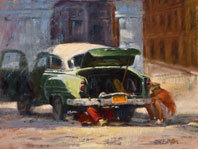Art in Cuba
There are no starving artists in Cuba. One reason for this is that each person receives food from the government each month: one quarter of a chicken, 5 eggs and 5 pounds each of rice, black beans and sugar. (Sugar is cheap in Cuba and heath care is free to the rising numbers of diabetics.) Artists there make more money than doctors, lawyers or university professors. Why? Because they are not, like the others, state employees, and are able to keep more of what they make. Again, why? Because Castro considers them cultural ambassadors and curators, and very important to keeping the Cubans....Cuban. Would it be worth it to live in Cuba, with the restrictions that entails, to be at the top of the food chain for a change? Not for me. But I can tell you that in many ways the young, hip, vibrant artists that I recently met on my trip to Havana were no different from artists here in the U.S. They were enthusiastic about their current work at the Biennial, complained about the price of art supplies which had to be imported from Europe and knew how to party. The Art gene is a powerful one.
I’ve just started paintings from that wonderful trip. The Cubanos are a beautiful, friendly group. The city of Havana reminds me of a stunning woman “of a certain age” whose beauty is still there under the surface of time’s wear, and I don’t know what they do to the black beans and rice (known as “Moors and Christians”) but my mouth waters just thinking about them. The Buena Vista Social Club music is in the air and makes you want to get up and dance in between endless rounds of mojitos and pina coladas. Oh, and then there are the cars--I took 360 photos of mid-century Chevys, Buicks and even one of the few 1956 Lincoln Continental Mark Twos in the western hemisphere. My first painting, shown here, is a common scene in Havana: a car is stopped dead on a city street and Cubanos are all over it, once more figuring out how to make it run again with no parts and no gas. That’s what I really loved about the people--they may be captive on their little island, but they sure know how to, in the words of Tim Gunn, “make it work.”
“A journey is a person in itself; no two are alike. and all plans, safeguards, policies and coercion are fruitless, we find after years of struggle that we do not take a trip; a trip takes us.”
John Steinbeck

